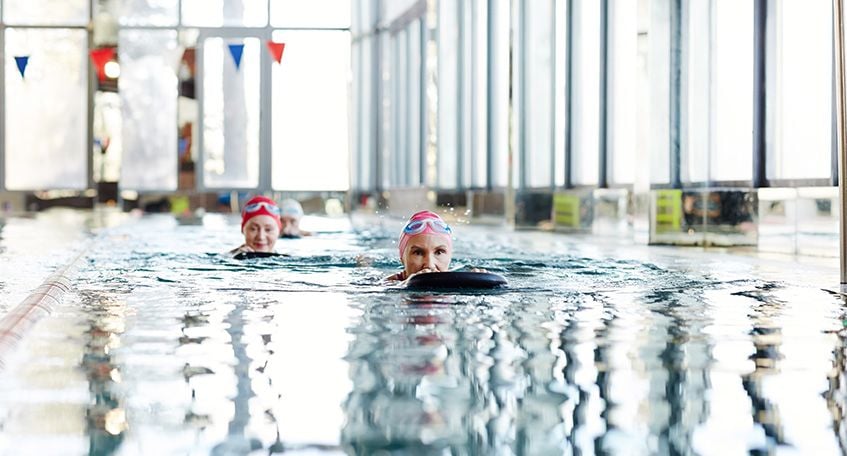Physical Activity for Cancer Survivors

Following the completion of cancer treatment, your oncology team is likely to suggest you begin some physical activity. The amount of exercise will be different for each survivor and will be based on the type of cancer treatments and surgeries you received, as well as side effects you may be experiencing.
Exercise is important for cancer survivors so that you can:
- Regain your stamina and strength
- Boost your mood
- Reduce fatigue
- Maintain a healthy weight
According to research published by the American Cancer Society, exercise can help some cancer survivors reduce the risk of cancer recurrence. An active lifestyle can also help reduce the risk of developing other health conditions including heart disease, type 2 diabetes, and even other types of cancer. Whether you’re a recent cancer survivor or have been cancer-free for years, it’s never too late to start adding exercise into your daily routine for better health.
In Early Survivorship, Talk to Your Doctor about Exercise
Anyone who is embarking on an exercise regimen for the first time or after a prolonged period of inactivity should talk to their doctor first. As a cancer survivor, make sure to ask your doctor questions such as:
- What types of activities are the safest and most beneficial for me?
- Are there any exercises or activities I should avoid?
- Should I focus on strength training (lifting weights, yoga, sit-ups, push-ups) or cardiovascular exercise (walking, running, swimming, cycling)?
- How often should I exercise and how long should each session last?
- Where can I find resources for group exercise or even cancer survivor exercise classes?
- Do I need to try to lose weight? If so, how much? Or, in some cases, do I need to gain weight. If so, how much?
Considerations When Planning Exercise as a Cancer Survivor
Realizing the importance of nutrition and physical activity to improve cancer survivors’ long-term treatment outcomes and quality of life, the American Cancer Society convened a group of nutrition, physical activity, and survivorship experts to identify best practices regarding nutrition and physical activities after cancer treatment. A group of physicians published their findings in CA: A Cancer Journal for Clinicians. Some notable findings regarding physical activity for cancer survivors include:
- For at least a few months after chemotherapy, or if you have been told that your white blood cell count is low, avoid public gyms and public pools where bacteria and viruses may be easily picked up on equipment or from the pool water.
- If you are feeling fatigued, try to get in at least 10 minutes of light exercise but avoid overdoing it or pushing yourself to the point of exhaustion. Some days you’ll feel better than others. Go a little longer on those days if you can. This can actually help improve fatigue for some survivors.
- If you have a skin reaction to radiation, or recently completed radiation therapy, try to avoid chlorine exposure in a pool or too much sun from outdoor exercise.
- If you have nerve pain (neuropathy) or tingling in your hands or feet, you may feel off balance. In this case, you may want to ride a stationary bike or walk on a treadmill where you can hold on.
Tips to Transition to an Active Lifestyle
When you think of physical activity as fun, but also a necessary step in staying healthy and reducing the risk of cancer recurring, you’ll find it much easier to commit to an exercise plan. You’ll also be more enthusiastic about exercise if you enjoy it. Especially in your early days as a cancer survivor, any activity is helpful! Walking your dog, walking in the park with a friend, taking a bike ride, even dancing around the living room with your grandchildren counts as exercise. The American Cancer Society recommends that as a cancer survivor beginning a new exercise routine you start slow, choose activities you enjoy, and aim to eventually exercise for at least 150 minutes per week.
You absolutely can break up that time into manageable intervals. Instead of going to the gym for 30 minutes one day, exercising at home for three 10-minute stints is just as effective. It’s often more manageable to work in frequent, short exercise breaks than committing to one long session. Additionally, if your doctor has instructed you to do both strength-building exercises (like lifting hand weights) and cardiovascular exercises (like walking or jogging), you can alternate between the two types of exercise. Not only will this help your body recover between workouts, but it will also help you stay more interested in your exercise routine.
When you learn to embrace exercise as something that may not have been possible during cancer treatment but that you’ve been cleared to do as a cancer survivor, you’ll learn to appreciate more about life because you will feel better. Eventually, exercise can once again become a natural, enjoyable part of your daily routine!

